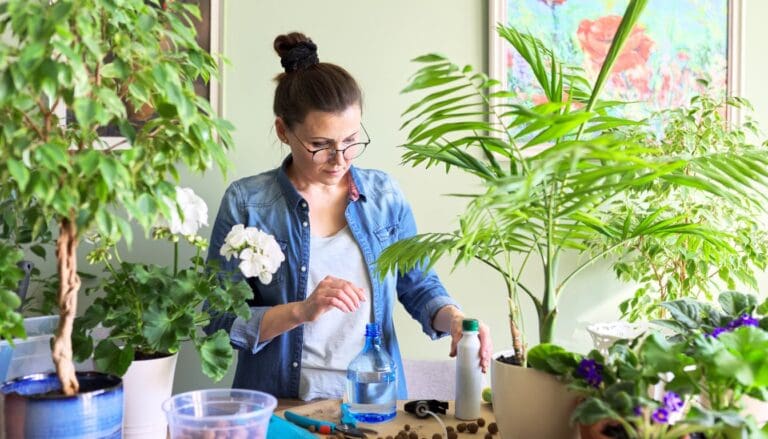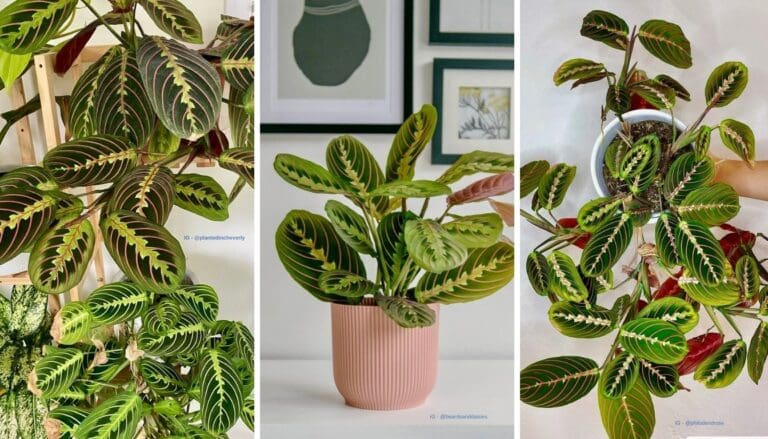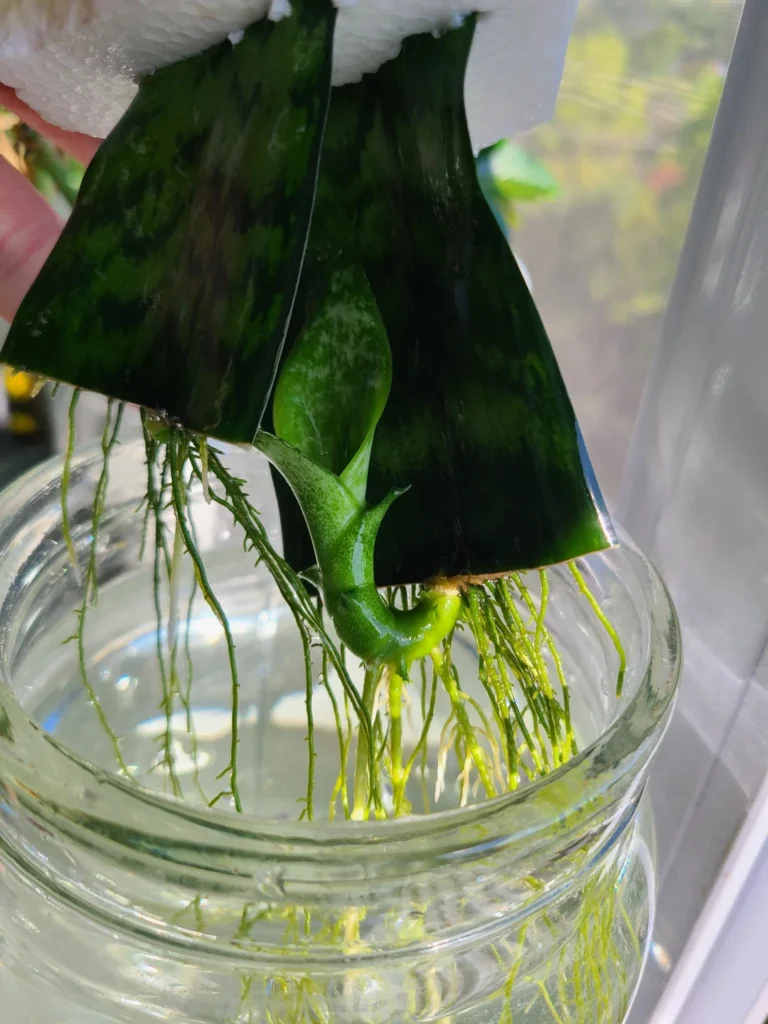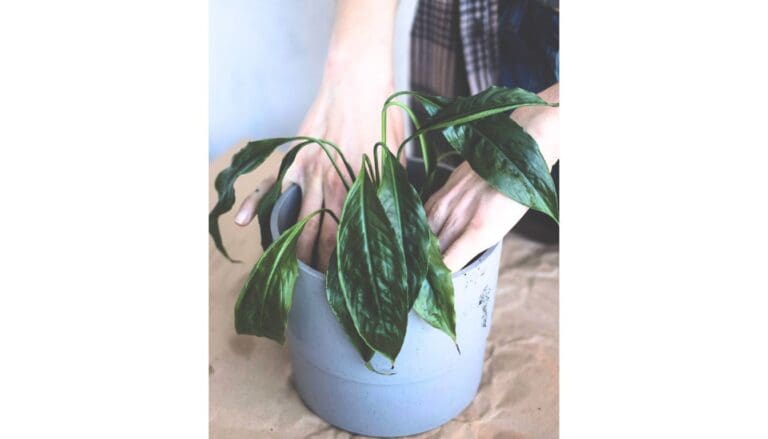Why Are My Indoor Plants Leaves Turning Brown? (Possible Problems+Solution)
If you are fond of indoor plants, you must have faced the problem of brown leaves at some point in time. Brown leaves are a common problem, similar to yellow leaves. The reasons for both these issues are more or less the same. However, there are some exceptions.
So, in this article, we shall learn all about why does indoor plant leaves turn brown and how you can fix the same.
Overwatering is the primary cause of brown leaves in indoor plants. Brown leaves can also happen due to excessive light and over-fertilization. While excessive light leads to brown spots on the leaves, overfertilization leads to brown tips, and overwatering leads to completely brown leaves.
Sometimes, you will find that despite doing everything right, the leaves turn brown. In that case, the reason might be aging. It is an entirely normal process, and nothing to worry about it.
It is troublesome to watch your houseplants suffering from brown leaves. It is more frustrating when you are unable to identify the real reasons behind it. Thankfully, the different patterns of browning can help you identify the exact cause.
If your indoor plants grow brown leaves, this article can help you. We have covered information about the different browning patterns to make it easier to identify the actual cause of browning leaves. So, without further delay, let’s get right into it.
Please note: Simplify Plants is reader-supported. Some links in the post are affiliate links and I get a commission from purchases made through links in the post.
Different patterns of browning

Brown leaves in houseplants can be caused due to several reasons. But different patterns have different reasons. Understanding the patterns will make it easy to identify the actual cause. Let us see the different patterns of browning:
Brown tips and edges: The leaves become brown at the tips, wrinkle, feel crispy and eventually fall off. Some leaves feel brittle when touched. The reasons can be watering issues.
When the roots fail to consume water, the plant becomes dehydrated. This affects photosynthesis. Due to less water, the plant starts growing brown tips and edges.
Sometimes overfertilization and salt buildup in the soil can also lead to brown tips and edges in indoor plants.
Brown patches: The leaves have brown patches or spots all over. Either there are several small spots or one big spot which increases in size when the condition deteriorates.
The problem is the leaf spot diseases due to fungus and bacteria. These either attack because the conditions are favorable for them or outside pathogens get transferred through strong winds.
Another reason is excessive light. Too much heat and light cause sunburn in the houseplants. Most houseplants cannot tolerate excessive sunlight.
Entire brown leaves: This happens when the leaves have ended their life cycle and are now old. Once they become old, they turn yellow and then brown.
In the end, they will become dry and will automatically fall off. In that place, again, new leaves will emerge. This happens with some particular leaves, and others remain healthy.
This happens with the lower leaves. It can also occur to other leaves, provided the cause is different.
When brown patches and tips start spreading, the whole leaf becomes brown. In such a case, all the leaves get affected and fall off.
Center of the leaves start browning: This happens during crown rot or root rot. Rotting happens when you overwater your plant.
Now that you have known the different patterns, it will be easier to recognize the reasons. Now let us talk about the different causes of brown leaves.
Different causes of brown leaves in indoor plants (+Remedies)
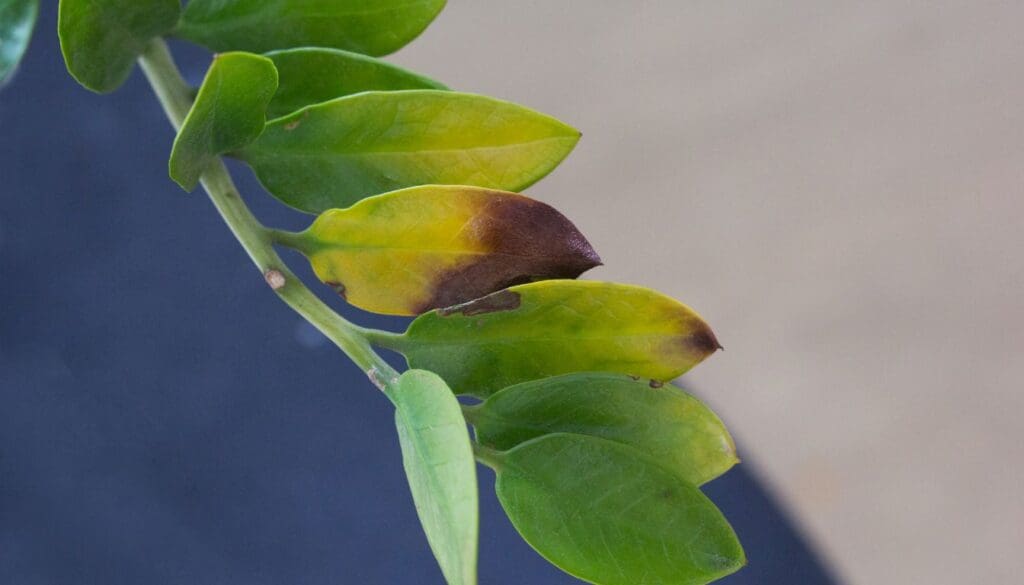
There are many causes of brown leaves. Some reasons are similar to the ones of yellow leaves, while some differ. I am talking about yellow leaves because, in various cases, the leaves start turning yellow and become brown.
Sometimes, one particular cause results in both yellow and brown leaves. But it differs in the pattern. So observe the patterns closely to identify correctly.
The reasons for brown leaves are:
- Moisture stress
- Improper light
- Inadequate fertilization
- Temperature stress
- Low humidity
- Pests and diseases
- Natural causes – Aging and Acclimatization
Now, let us discuss all of these.
Moisture stress
Moisture stress happens because of two things – overwatering and underwatering.
Watering depends on the type of plant, size of the plant, drainage, pot size, temperature, and humidity. You need to water adequately, keeping these things in mind.
Overwatering

Your indoor plants will get overwatered when you constantly water your plants without checking the moisture level. It is crucial to keep the plant moist, not wet. Sometimes, we water a lot without understanding the moisture level and end up overwatering.
If the soil does not have a sound drainage system, the excess water is stored in the soil and causes overwatering issues. Most houseplants need infrequent deep watering. Watering them once a week will help them remain moist the whole week.
When you overwater your houseplants, the roots get suffocated due to a lot of water. The roots cannot breathe freely and thus cannot consume the water from the soil.
As a result, water fails to reach different parts, i.e., the stems and the leaves. Ultimately, the leaves start turning brown at the tips and edges due to a lack of moisture.
Underwatering
Brown tips and edges on the leaves occur because you are probably not watering them well. When you water your plant less, the main portions absorb the water so quickly that they cannot reach the tips and edges. Due to this, the tips and edges turn brown.
How to fix it?
First, concentrate on the proper watering schedule. Watering the houseplants thoroughly once a week will maintain the perfect moisture level for the plants.
- Water the plant well from all sides.
- The pot should have drainage holes so that excess water flows out through it. Keep checking the moisture.
- Remember that big plants will need more water than smaller ones.
- During the summers, the plants will need more water than in winters.
Proper watering will help to maintain the correct humidity for the plant.
Coming to the soil, it must have a sound drainage system. The soil must support both water drainage and moisture retention.
Avoid using clayey or sandy soil. The first one holds water for a long time, whereas the second one drains water too quickly. If your soil medium has more of these, adding compost will help with drainage and moisture retention.
Direct sunlight

Indoor plants will grow well under indirect sunlight. Fewer plants need direct sunlight. Most of them need indirect sunlight. Exposing them to direct sunlight will cause brown dead patches on the leaves, indicating sunburns.
The intense heat of light burn the cells of the leaves and kill them. However, the plant will grow leaves again. But the old leaves with brown patches will not recover.
How to fix it?
Most of the time, sunburn occurs when you take your houseplants outdoors in the summers. Intending to give them light, you end up exposing them to direct sun.
It is better to keep them indoors near windows. Sunlight from the window has a positive impact on the plants than the outdoor sun.
A north or east-facing window will be best for most houseplants as it gives bright, less intense sunlight. You can also use south or west-facing window. If the sun is intense, pull down curtains or blinds to create a filter for the direct sun.
Inadequate fertilizer
The plants need a good amount of nutrients to grow strong and healthy. The soil mix that we make for the houseplants already contains a lot of nutrients.
But over time, they get washed away with each watering. That is the reason fertilizing is essential.
But that doesn’t mean that we should fertilize them frequently. Houseplants work well when fertilized once a month. The correct time to fertilize is when the plants are growing and blooming.
Underfeeding the plants causes yellow leaves. To solve this problem, we sometimes use too much fertilizer but end up overfertilizing, causing brown tips.
Over-fertilization draws out the nutrients from the plant cells in a process known as reverse osmosis, which causes brown tips.
Another reason for brown tips is salt accumulation. When you over-fertilize the plants, the salt gets accumulated in the soil. All the water gets consumed by the salts. Due to this, the plant cannot get the water causing brown tips and edges.
Stunted growth, wilted leaves, and dying root tips are all signs of salt burn.
How to fix it?
To solve the problem of over-fertilization, first, stop fertilizing. To remove salts, flush the soil very well with water.
For this, your pot must have suitable drainage holes. Allow the soil to dry out completely. Water the plant very well. Concentrate more on the soil.
In the first watering, allow 20-30% of water to flush through the potholes. With this, all the salts will drain out along with the water. Repeat it.
Using fewer amounts of fertilizers will cause less harm than over-fertilization.
Temperature stress
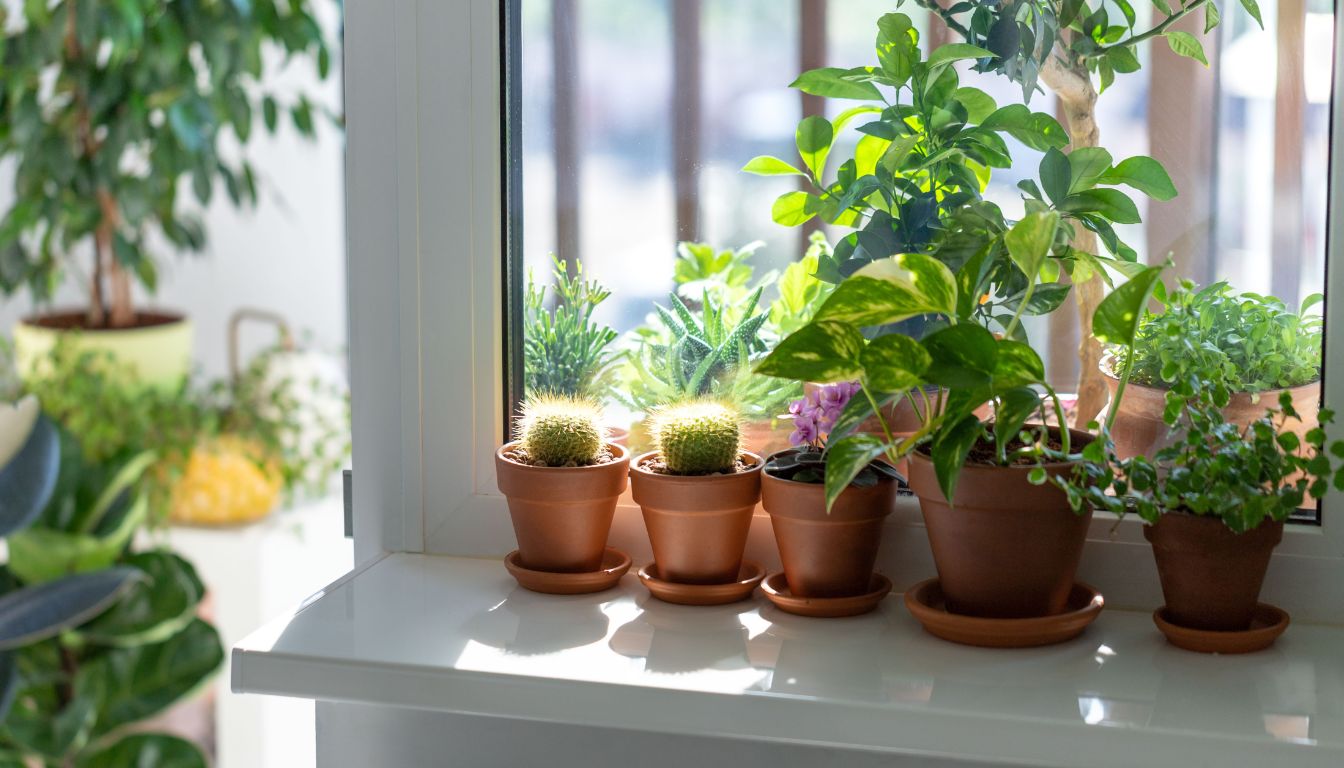
Houseplants will tolerate the same temperatures that humans can bear. That is the reason they are “houseplants.” Exposing them to the wrong temperature or frequent temperature fluctuations will cause brown tips.
When your houseplant is exposed to high temperatures, the soil dries out. This makes the plant dehydrated and lowers the humidity. Due to dehydration, the leaf starts turning brown at the tips, curl and wilt. The flower buds fall from the plants, and no blooms remain.
How to fix it?
Try to keep the plant away from the direct sun rays, especially during the summers. Place your houseplants near a window in the north or east direction. It gives bright sunlight, which is less intense.
Keep the houseplants away from heated areas, like the kitchen, heaters, or radiators. You can keep the plants in an air-conditioned room to lower the temperature. But keep them away from the AC to avoid the cold, dry air.
Also, water the houseplant frequently to keep the soil moist, not wet.
Low humidity
Our houses have lower humidity levels than outside. Especially during the dry winters, the humidity level drops significantly.
However, during the summers, the humidity mostly remains high. It might be uncomfortable for us but suitable for tropical houseplants.
When the humidity level drops too low, the plant starts showing signs of low moisture by browning at the tips.
How to fix it?
Most of the houseplants are tropical plants. They require high humidity to thrive. We cannot provide them with such high humidity as their native lands. But at least half of what is needed can be provided.
You can mist the plants regularly. But it would be a temporary solution.
You can keep your houseplants over a pebble tray with water. Make sure that the pot doesn’t touch the water.
If your room has many houseplants, installing a humidifier in the room will be best. Humidifiers can mimic the exact humidity the plants need.
Pests and diseases

If you find little brown spots on the leaves, it might signify that spider mites have attacked your plant. You will notice fine web lines under the leaves.
Many other pests cause brown spots – aphids, mealybugs, thrips, and whiteflies. They suck all the nutrients from the plant, making it lifeless.
If you keep your plant and the leaves damp for a long time, fungus and bacteria will grow. Brown spots with yellow circles or brown spots all over the leaves and stems indicate that your plant is undergoing a pest infestation or fungal disease.
Some diseases that cause brown spots are:
Edema: The plants develop small brown bumps. These bumps remain tightly attached to the leaves. These are caused due to overwatering. However, it is not a disease because it is not life-threatening. It won’t get cured, and the leaves will remain like that forever.
Root rot: This happens if your plants undergo overwatering for a long time. It shows signs like brown tips and edges. The center part of the leaves also starts browning. If neglected, the condition worsens, and the roots start rotting. The soil also releases a foul smell.
Powdery mildew: First, you will see white substances that resemble scattered powder. Once the disease increases, the leaves develop brown patches and become distorted. A lot of different pathogenic fungi cause this.
Ringspot virus: This is a viral infection. The symptom is a yellow ring with a brown spot in the center.
Gray mold: This infection is caused by the fungus Botrytis cinerea. The signs are brown spots on the leaves and flowers. It happens when the plant remains damp for a long time.
Anthurium blight: This is a leaf spot disease caused by a bacterial pathogen. First, the spots will look water-soaked. Later, it dries up and turns brown.
How to fix it?
First, you need to isolate the plant. This will help to avoid spreading the pests and diseases to other plants.
Remember, there is no guarantee that these issues won’t happen again. If the condition of the plant is ideal, they will again come back.
Give your plant a good shower to wash away all the pests. Still, if some pests are left, handpick them. Spray your plant with neem oil. It is a perfect solution for treating both pests and fungus infections.
For removing pests, you can use mild dish wash soap. Mix one tablespoon of dish wash with a four-ounce spray bottle filled with water. Mix well and spray to the plant. Leave it for some hours, then rinse the plant.
Many herb sprays will help you eliminate the pests – rosemary, lavender, sage, peppermint, basil.
For treating diseases, the best thing is prevention. But if your plants are already showing the symptoms, that means the disease has already started.
To remove it, isolate the plant and remove the affected parts.
If the condition is so severe that you cannot treat it yourself, you will have to use pesticides, miticides, and fungicides to treat the problems.
Before using, read the instructions carefully on the labels of the products. Overusing them might harm the plant more.
If the condition is bad, especially the roots, you will have to repot your houseplants. Take out the plant, cut off the affected roots, apply some fungicide to the infected areas and let it heal.
Use a new pot and fresh soil mix for repotting. The old ones might have bacteria and fungus. Avoid watering and fertilizing for some time. Give the plant time to heal. Spraying neem oil once a month will prevent pests and diseases.
Natural browning

Browning happens due to natural causes. Mainly natural browning occurs due to aging and acclimatization. There is no treatment for these natural causes.
Aging
When your plant has matured and is at the end of its life cycle, the leaves will entirely start turning brown.
Slowly the whole leaf will turn brown and dry. Eventually, the leaves will automatically fall from the plant.
Acclimatization
When you change the plant’s location, like traveling from one place to another or transplanting, the leaves might turn brown due to shock.
The plants were used to one kind of environment. A sudden change in the environment stresses the plant. But there is nothing to worry about.
Take good care of the plant and give the plant some time to get adjusted to the new environment. Once they start getting used to the new climate, soil, and surroundings, they will start growing green and healthy.
How to cut the brown tips in the leaves?
Instead of removing the whole leaf, you can cut off only the browning at the tips and edges, maintaining the shape. You will need a sharp, sterilized pruner or scissor to prune.
Cut off the brown portion from the leaves. While cutting, replicate the natural shape of the leaves by making an angled cut. After some days, the cut portion will blend automatically.
How to remove brown leaves from the houseplant?
The leaves which have turned brown completely will not turn green. So it is better to remove them. Other than that, you can remove the leaves with brown spots or patches to avoid spreading any diseases or pests.
For pruning, you will need sharp, sterilized pruners or scissors. Sharp edges will help in making a precise cut. Sterilizing will help in avoiding the spreading of bacteria or fungus.
Remember these while cutting entire brown leaves:
- Make clear cuts.
- Do not remove more than 25% of the entire plant.
- Cut in steps to avoid removing too many leaves at the same time.
Final words
Now that you know the reasons behind brown leaves, you need to care for your indoor plants to avoid browning. Provide all their basic needs sufficiently. Whenever you see any adverse reactions on your houseplants, fix them in the first place.
Pruning the brown leaves helps the plant prevent energy from getting used to the damaged plant and save energy to concentrate on growing new leaves.
Do not get disheartened, as the browning can be natural if the plant is old or if it has been exposed to a new environment. All it needs is some time to get used to the new surroundings, and it will again start growing all green and healthy.
Recommended Garden Supplies
| Product Image | Our Recommended Gardening Supplies | Check Offers! |
|---|---|---|
Top Top
Top
Top
Top
Top
Top
Top
Top | rePotme Houseplant and Tropical Classic Potting Soil Mix | Check Offer On Amazon |
 Top
Top
Top
Top
Top
Top
Top
Top | Espoma Organic Indoor Plant Food | Check Offer On Amazon |
 Top
Top
Top
Top
Top
Top
Top
Top | GooingTop LED Grow Light 6000K Full Spectrum Clip Plant Growing Lamp | Check Offer On Amazon |
 Top
Top
Top
Top
Top
Top
Top
Top | Soil Moisture Meter | Check Offer On Amazon |
 Top
Top
Top
Top
Top
Top
Top
Top | Govee Hygrometer Thermometer, Bluetooth Enabled! | Check Offer On Amazon |
 Top
Top | LEVOIT Humidifiers for Large Room(Best For Plants) | Check Offer On Amazon |
 Top
Top
Top
Top
Top
Top
Top
Top | Upgraded DIY Automatic Drip Irrigation Kit, 15 Potted Houseplants Support | Check Offer On Amazon |
 Top
Top
Top
Top
Top
Top
Top
Top | Stainless Steel Heavy Duty Gardening Tool Set | Check Offer On Amazon |
 Top
Top
Top
Top
Top
Top
Top
Top | Bonide Insecticidal Soap | Check Offer On Amazon |
 Top
Top
Top
Top
Top
Top
Top
Top | Bonide 32 oz Spray Neem Oil for Organic Gardening | Check Offer On Amazon |
 Top
Top
Top
Top
Top
Top
Top
Top | Garden Safe Fungicide | Check Offer On Amazon |

